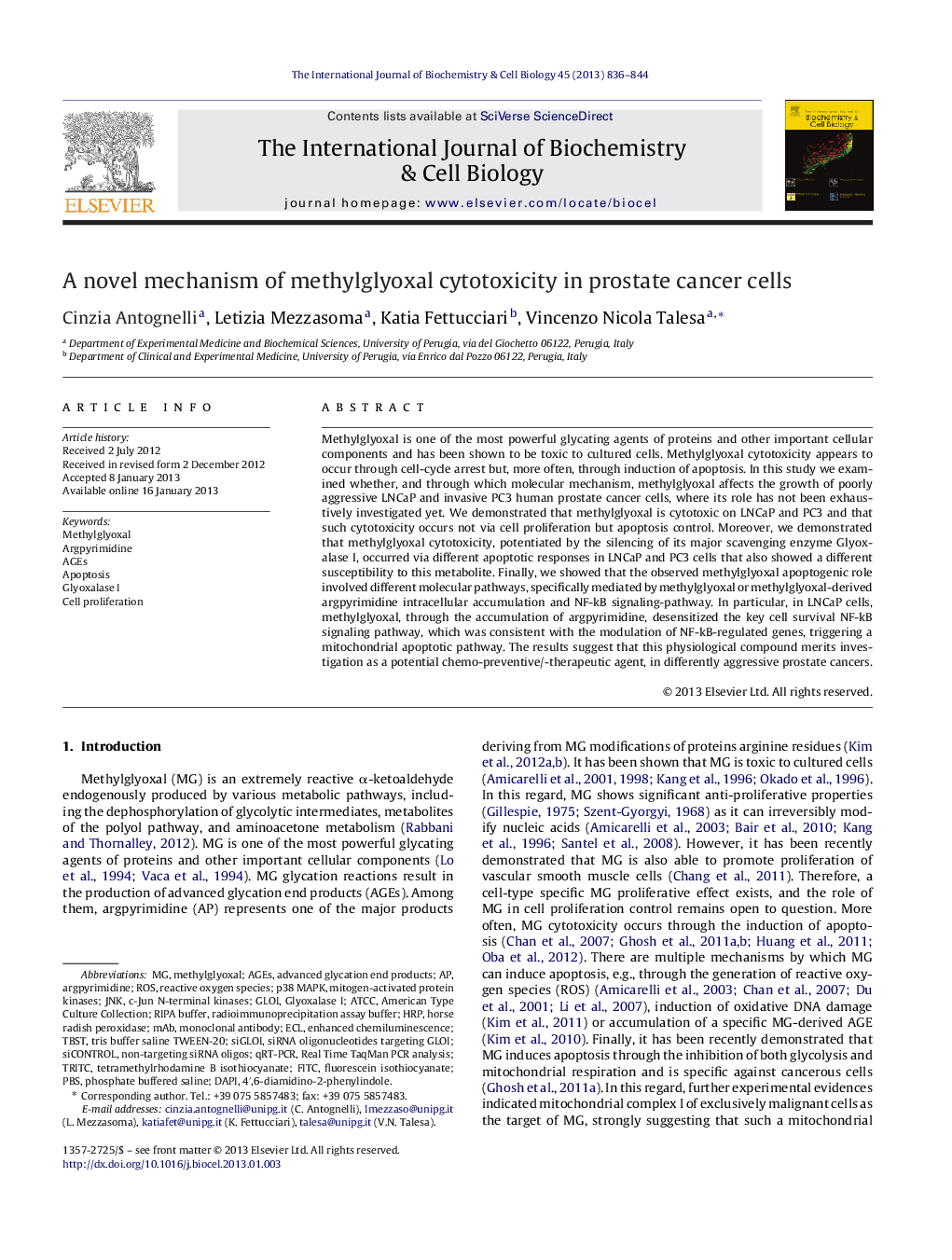| کد مقاله | کد نشریه | سال انتشار | مقاله انگلیسی | نسخه تمام متن |
|---|---|---|---|---|
| 8324223 | 1539907 | 2013 | 9 صفحه PDF | دانلود رایگان |
عنوان انگلیسی مقاله ISI
A novel mechanism of methylglyoxal cytotoxicity in prostate cancer cells
ترجمه فارسی عنوان
یک مکانیسم جدید سمیت سلولی در سلولهای سرطانی پروستات
دانلود مقاله + سفارش ترجمه
دانلود مقاله ISI انگلیسی
رایگان برای ایرانیان
کلمات کلیدی
AGEsTetramethylrhodamine B isothiocyanateTRITCTBSTATCCECLDAPIqRT-PCRHRPFITCJnkPBSmAb4′,6-diamidino-2-phenylindole - 4 '، 6-دیامیدینو-2-فنیلینولc-Jun N-terminal kinases - C-Jun N-terminal kinasesp38 MAPK - P38 MAPKROS - ROSMonoclonal antibody - آنتی بادی مونوکلونالArgpyrimidine - ارگپیریمیدینRIPA buffer - بافر RIPAradioimmunoprecipitation assay buffer - بافر تست radioimmunoprecipitationenhanced chemiluminescence - بهبود شیمیایی لومنCell proliferation - تکثیر سلولیApoptosis - خزان یاختهایPhosphate buffered saline - فسفات بافر شورfluorescein isothiocyanate - فلوئورسین ایسوتیوسیاناتMethylglyoxal - متیل گلی اکسالAmerican Type Culture Collection - مجموعه فرهنگی نوع آمریکاییAdvanced glycation end products - محصولات نهایی پیشرفته گلیساسیونhorse radish peroxidase - پراکسیداز تربچه اسبmitogen-activated protein kinases - کیناز پروتئین فعال Mitogenglyoxalase I - گلیوکسیلاز IReactive oxygen species - گونههای فعال اکسیژن
موضوعات مرتبط
علوم زیستی و بیوفناوری
بیوشیمی، ژنتیک و زیست شناسی مولکولی
زیست شیمی
چکیده انگلیسی
Methylglyoxal is one of the most powerful glycating agents of proteins and other important cellular components and has been shown to be toxic to cultured cells. Methylglyoxal cytotoxicity appears to occur through cell-cycle arrest but, more often, through induction of apoptosis. In this study we examined whether, and through which molecular mechanism, methylglyoxal affects the growth of poorly aggressive LNCaP and invasive PC3 human prostate cancer cells, where its role has not been exhaustively investigated yet. We demonstrated that methylglyoxal is cytotoxic on LNCaP and PC3 and that such cytotoxicity occurs not via cell proliferation but apoptosis control. Moreover, we demonstrated that methylglyoxal cytotoxicity, potentiated by the silencing of its major scavenging enzyme Glyoxalase I, occurred via different apoptotic responses in LNCaP and PC3 cells that also showed a different susceptibility to this metabolite. Finally, we showed that the observed methylglyoxal apoptogenic role involved different molecular pathways, specifically mediated by methylglyoxal or methylglyoxal-derived argpyrimidine intracellular accumulation and NF-kB signaling-pathway. In particular, in LNCaP cells, methylglyoxal, through the accumulation of argpyrimidine, desensitized the key cell survival NF-kB signaling pathway, which was consistent with the modulation of NF-kB-regulated genes, triggering a mitochondrial apoptotic pathway. The results suggest that this physiological compound merits investigation as a potential chemo-preventive/-therapeutic agent, in differently aggressive prostate cancers.
ناشر
Database: Elsevier - ScienceDirect (ساینس دایرکت)
Journal: The International Journal of Biochemistry & Cell Biology - Volume 45, Issue 4, April 2013, Pages 836-844
Journal: The International Journal of Biochemistry & Cell Biology - Volume 45, Issue 4, April 2013, Pages 836-844
نویسندگان
Cinzia Antognelli, Letizia Mezzasoma, Katia Fettucciari, Vincenzo Nicola Talesa,
